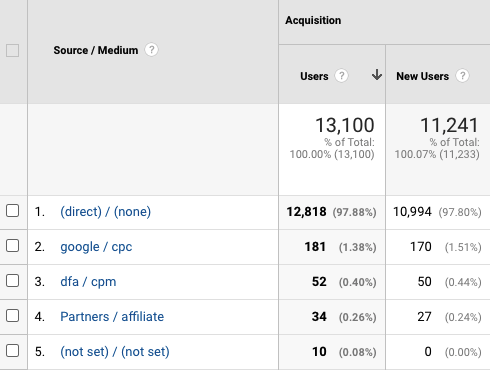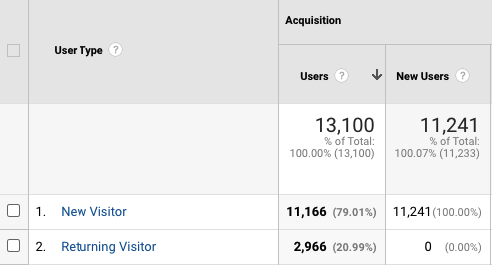How to Measure Digital Marketing Success: 7 Metrics to Watch
Did you know that over 72% of companies haven’t looked at their ad campaigns in over a month?
And that’s just the beginning.
Far too many companies forgo monitoring their digital marketing performance, often because they don’t know how to measure digital marketing success. Without constant measuring and monitoring, you’re watching your budget go straight down the toilet.
But it’s not too late to start tracking your campaigns!
On this page, we’ll cover how to measure digital marketing success by sharing seven metrics to watch. Keep reading to learn more!

For even more digital marketing advice, sign up for the email that more than 190,000 other marketers trust: Revenue Weekly.
Sign up Today!
How to set up your digital marketing campaigns for success
Before we launch into how to measure digital marketing, let’s first talk about how to set your campaigns up for success. There are three key things you need to do to ensure you can accurately and effectively measure your campaigns:
- Set SMART goals
- Know vanity metrics
- Set up Google Analytics
Let’s dive into each of these more below!
1. Set SMART goals
You can’t measure marketing success without setting goals first. If you don’t know what you’re trying to achieve, you won’t be able to measure your campaign’s success and performance accurately.
To accurately measure campaign performance, set SMART goals. SMART stands for:
- Specific: Your goals should be precise on what you want to achieve.
- Measurable: You should be able to measure whether you achieved your goal.
- Achievable: You should be able to accomplish your goals.
- Realistic: Your goals should be within reach and relevant to your business.
- Timely: You should have a deadline to achieve your goal.
SMART goals are best for digital marketing because they encourage you to create precise goals to look at metrics and determine if you achieved what you wanted to accomplish.
If you set a generic goal like “Earn more leads,” it’s hard to know if you achieved that goal. How many leads is “more?” How soon do you have to earn these new leads? How do you measure the goal?
With a goal so generic, it’s challenging to look at your digital marketing metrics and know if you’re reaching that goal.
On the other hand, SMART goals make it easy for you to take your digital marketing metrics and determine if you’re achieving what you want to achieve. A goal like “Increase sales by 25% for Q1” is easy to track and monitor to see if you reach it.
2. Know vanity metrics
When you look at digital marketing metrics, it’s easy to get overwhelmed with all the numbers available to your business. However, before you start measuring results in marketing, you need to know vanity metrics.
Vanity metrics are metrics that look good but have no bearing on your business’s digital marketing success. Essentially, these metrics don’t provide any indication that your marketing campaigns are succeeding.
Some examples of vanity metrics include:
- Followers
- Pageviews
- Subscribers
- Running total of customers
For example, if you track your social media followers and find your Facebook page has 5000 followers, you may think it’s a sign of success with your social strategy. But are those 5000 followers engaging with your content? Are they buying your products?
Having followers doesn’t necessarily mean you’re achieving your goals, whether it’s earning leads or sales –– that’s why you want to stay away from using these metrics to measure your overall success or returns.
3. Set up Google Analytics
If you want to measure digital marketing success, you must set up Google Analytics. Google Analytics enables you to keep all your campaign data in one place and analyze your performance.
Here’s the simplistic version of how to set up Google Analytics:
- Create or sign up with your Google account
- Set up your property
- Build your property’s reporting view
- Add the Google Analytics tracking code to your website
To get a more in-depth overview, check out our blog post on how to set up Google Analytics for your business!
How to measure digital marketing success: 7 digital marketing metrics to monitor
Ready to measure digital marketing success?
Here are seven key metrics you’ll want to monitor to see if you drive success with your campaigns:
1. Traffic by source
If you want to know how to measure digital marketing success, start by monitoring your traffic by source. You can find this metric in Google Analytics by going to:
Acquisition > All Traffic > Source/Medium

This metric is critical to monitor because it indicates where you get your traffic.
Google Analytics will tell you where traffic comes from, including places like:
- Direct
- Paid Search
- Display
- Affiliates
- Other
This metric helps you see critical information about marketing campaign performance. You can see which channels drive the most traffic and the most qualified leads for your business, which can help you make more actionable decisions about your marketing.
For example, after looking at your traffic by source, you may find that you’re getting many conversions from your pay-per-click (PPC) ads. As a result, you opt to double down and allot more resources to PPC to increase conversions.
2. Returning visitors
When you measure marketing success, be sure to track your returning visitors. Returning visitors are people who come back to your site after visiting it for the first time.
You can track returning visitors in Google Analytics by going to:
Audience > Behavior > New vs. Returning

Here you can compare how many new visitors you have versus your returning visitors.
This metric is an excellent indicator of the user experience you deliver. When you provide a relevant and positive user experience, you’re likely to have a higher rate of returning users. This metric can indicate that:
- You provide a functional website that users enjoy browsing
- You create marketing campaigns relevant to your audience
Returning visitors are critical to helping you earn revenue for your business. By tracking this metric, you can see if your digital marketing campaigns successfully drive people back to your website to learn more about your business and convert.
3. Average session duration
If you want to know how to measure digital marketing success, make sure you monitor your average session duration. Your average session duration indicates the typical amount of time visitors spend on your site when they visit.
To track the average session duration for your marketing channels, go to the following in Google Analytics:
Acquisition > All Traffic > Channels

Here you can see the average session duration for each channel, from paid search to direct.
Generally, you want to have a higher average session duration because it indicates visitors are spending time on your site getting to know your business and products or services. When users spend more time on your site, they’re more likely to convert.
Additionally, if you click on individual channels and view each campaign, you can see which campaigns keep users engaged longer. You can analyze those campaigns to figure out why users spend more time on those pages and use your results to inspire other campaigns.
4. Exit rate
When measuring results in marketing, make sure you include exit rate as one of your digital marketing metrics. Your exit rate shows you how often visitors exit from a page after viewing any number of pages on your site.
You can find exit rate in Google Analytics by going to:
Behavior > Site Content > All Pages

So, how does exit rate indicate success with digital marketing?
Well, exit rate can show you where you’re not successful with digital marketing. If you have pages with an unnaturally high exit rate, it’s an indication that something isn’t working with that page or campaign.
For example, let’s say you look at your pages and notice that a product page has an abnormally high exit rate. It may indicate that information is missing, the “add to cart” button is broken, or something similar that’s causing a negative user experience.
Keep in mind –– some pages naturally have a high exit rate. If you have a page with a form submission, for example, you’re likely to have a high exit rate because people fill out the form and leave. So, make sure you consider the context of your page before you try to optimize it to improve.
5. Bounce rate
When you measure results in marketing, you want to make sure you monitor your bounce rate. Your bounce rate indicates how many people leave your page without visiting any other pages on your site.
You can find this metric in Google Analytics by going to:
Behavior > Site Content > All Pages

While bounce rate and exit rate may seem like the same metric, they’re slightly different. Bounce rate calculates people leaving the page used to enter your site. On the other hand, exit rate looks at the last page users visited — someone could visit multiple pages before exiting.
You want to monitor pages with a high bounce rate because it can indicate a poor experience.
Your pages may have a high bounce rate due to:
- Your site taking too long to load
- Information being irrelevant to the search
- Website errors
6. Conversion rate
If you want to know how to measure digital marketing success, know that you can’t measure it without including conversion rate as one of your metrics. Your conversion rate indicates how many people convert when visiting pages on your site.
You can find data about your conversion rate in Google Analytics by going to:
Conversions > Goals > Overview

When you track conversion rates, keep in mind that you can track multiple types of conversions.
You can track conversions like:
- Sales
- Subscriptions
- Sign-ups
- Downloads
Tracking this metric is critical to see if your marketing campaigns drive the best results for your business.
How to measure digital marketing success: Partner with a top-rated marketing company
When you measure digital marketing success, you can see if your campaigns are working for your business. But if you don’t know where to start with measuring results in marketing, WebFX can help.
We have a team of over 300 marketing experts familiar with creating, launching, and monitoring digital marketing campaigns. Our team creates campaigns that drive results –– we’ve driven over $2.4 billion in revenue and over 6.3 million leads for our clients in the past five years alone.
Ready to get help with your digital marketing? Contact us online or call us today at 888-601-5359 to speak with a strategist about our digital marketing services!